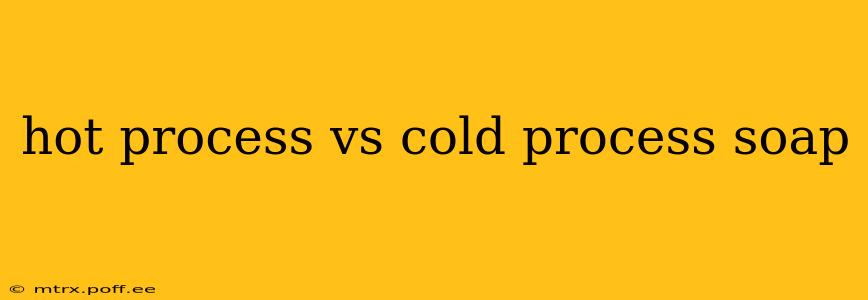Choosing between hot process and cold process soap making might seem daunting, but understanding the key differences can help you decide which method suits your needs and preferences best. Both methods produce soap, but they differ significantly in their processes, resulting in variations in the final product's characteristics. This guide delves into the specifics of each method, addressing common questions and highlighting their respective pros and cons.
What is Cold Process Soap Making?
Cold process soap making involves a relatively simple, hands-off approach. The process begins by combining oils and lye (sodium hydroxide) in a careful and precise manner. This mixture, called saponification, generates heat through a chemical reaction, but it's not heated externally. The resulting soap mixture, or batter, is then poured into molds to cure. This curing process, which can take several weeks, allows excess water to evaporate, and the soap to harden and become milder.
Advantages of Cold Process Soap Making:
- More control over ingredients: Cold process allows for greater creativity and customization in choosing oils, butters, additives, and essential oils.
- Natural and milder: The curing process leads to a naturally milder soap, often preferred by those with sensitive skin.
- Beautiful swirls and designs: The slower setting time of cold process soap allows for intricate designs and swirls, increasing its aesthetic appeal.
Disadvantages of Cold Process Soap Making:
- Longer curing time: The curing period can last 4-6 weeks, requiring patience.
- Potential for lye burns: While proper safety measures are essential, there is a greater risk of accidental lye burns during mixing.
- Less predictable results: Beginners might find it challenging to achieve consistent results initially, requiring practice and precise measurements.
What is Hot Process Soap Making?
Hot process soap making speeds up the saponification process using external heat. The mixture is heated, usually in a double boiler or crockpot, until it reaches a trace (a pudding-like consistency). This accelerates the saponification reaction, significantly reducing the curing time. The soap is then poured into molds, and requires less curing time.
Advantages of Hot Process Soap Making:
- Faster curing time: The soap is ready to use much sooner, often within a day or two after making.
- Less chance of lye burn: The heating process essentially neutralizes the lye more rapidly, reducing the risk of lye burns.
- More predictable results: The accelerated process leads to more consistent results, particularly beneficial for beginners.
Disadvantages of Hot Process Soap Making:
- Less control over ingredients: The heat can affect the delicate properties of certain oils and additives, limiting customization options.
- Can be harder on the skin: The accelerated process might result in a slightly harsher soap, especially initially.
- Less aesthetically pleasing: The rapid saponification often prevents creating intricate swirls or designs in the soap.
What is the Difference in the Final Product?
The primary difference lies in the final soap's characteristics. Cold process soaps often have a smoother, more refined lather, and tend to be milder on the skin due to the longer curing time. Hot process soaps, while still effective cleansers, may have a slightly harsher lather and a more rustic appearance. The scent of essential oils might also be more pronounced in hot process soaps due to the shorter cure time.
Which Method is Right for Me?
The best method depends on your priorities. If you value customization, have patience, and enjoy creating beautiful soap designs, cold process might be ideal. If you want faster results, prioritize safety and consistency, or are a beginner, hot process is often recommended.
How Long Does it Take to Make Soap Using Each Method?
Cold Process: The actual soap-making process takes about 30-60 minutes. However, the curing time adds several weeks before it’s ready to use.
Hot Process: The process takes about 2-3 hours, including the heating and saponification time, but the soap can be used within a day or two after making.
Is One Method Better Than the Other?
Neither method is inherently "better." The choice depends entirely on personal preferences, time constraints, and desired end results. Both methods produce functional and effective soaps.
Can I Use the Same Recipes for Hot and Cold Process?
While many recipes can be adapted, some ingredients might react differently to heat. Always research whether your chosen oils and additives are suitable for both methods before making adjustments. It's usually safer to start with recipes specifically designed for each process.
This comprehensive guide sheds light on the key differences between hot process and cold process soap making, empowering you to choose the method that best aligns with your experience level, preferences, and goals. Happy soap making!
